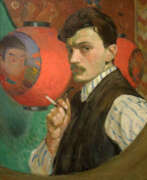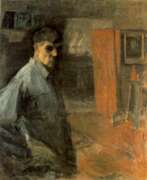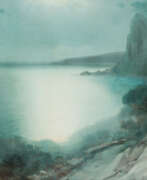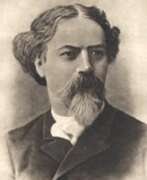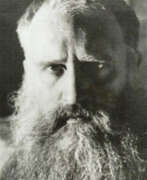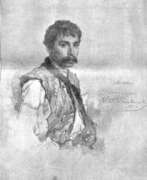Ukraine Symbolism


Konstantin Fyodorovich Bogaevsky (Russian: Константин Фёдорович Богаевский), a Russian painter renowned for his Symbolist landscapes, was a significant figure in the art world between the late 19th and early 20th centuries. Born in Feodosia, Crimea, to an old Italian-German family, Bogaevsky's initial art education came from Ivan Aivazovsky. His formative years were spent at the Imperial Academy of Arts under Arkhip Kuindzhi, where despite facing criticism and temporary expulsion for "lack of talent," Kuindzhi's protection and faith in his abilities paved the way for Bogaevsky's future successes.
Bogaevsky's travels to Italy and France in 1898 introduced him to the works of Claude Lorrain, who Bogaevsky considered his true mentor. This experience, coupled with a later discovery of Andrea Mantegna's paintings in 1911, significantly influenced his work. His artistry is noted for its dream-like symbolist landscapes, often of an imaginary land known among his circle as "Bogaevia." Maximilian Voloshin's essays, titled "Konstantin Bogaevsky," played a crucial role in popularizing Bogaevsky's work, drawing parallels between him and Nicholas Roerich.
Throughout his career, Bogaevsky was affiliated with several art groups, including Mir iskusstva, Union of Russian Artists, and Zhar-Tsvet. His exhibitions, notably the 1906 Exposition de l'Art Russe organized by Sergei Diaghilev, highlighted his unique blend of Symbolism and later influences from Renaissance masters like Mantegna, Dürer, and Altdorfer. Despite the October Revolution driving him into relative obscurity, Bogaevsky's legacy as a master of Symbolist landscapes endures, with works like the 1932 "Port of an Imaginable City" still celebrated for their artistic value.
Bogaevsky's works are represented in major museums, including the Tretyakov Gallery, Russian Museum, and Feodosia Art Gallery. His death in Feodosia during a Soviet air raid in 1943 left behind a legacy enriched by his exploration of historical landscapes and symbolist vistas, immortalizing him as a visionary of his time.
For collectors and experts in art and antiques, Bogaevsky's oeuvre offers a fascinating journey into the melding of historical reverence and symbolist imagination. His works, steeped in the influences of European masters and his unique vision of an imaginary land, continue to captivate and inspire. To stay updated on exhibitions and auction events featuring Konstantin Fyodorovich Bogaevsky's work, signing up for updates is highly recommended. This subscription will ensure you are always informed about new sales and the opportunity to own a piece of this historical and symbolist art legacy.
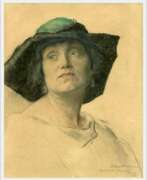

Olga Lyudvigovna Della-Vos-Kardovskaya (Russian: Ольга Людвиговна Делла-Вос Кардовская) was a Russian painter and graphic artist, whose works and life story continue to fascinate art collectors and experts. Born in Chernigov in the Russian Empire in 1875 and passing away in Leningrad, USSR in 1952, Della-Vos-Kardovskaya's artistic journey was marked by rigorous training and profound experiences. Her educational path took her from the Schneider School in Kharkov to the Academy in Saint Petersburg, and finally to Munich, where she studied under Anton Ažbe. The year 1900 was significant for her, marking not only a milestone in her artistic education but also her marriage to the painter Dmitry Kardovsky.
Della-Vos-Kardovskaya's career was characterized by her participation in various artist societies and exhibitions, significantly contributing to her recognition in the art world. Between 1903 and 1917, she exhibited her work with the New Society of Artists and the Union of Russian Artists. Her association with the Zhar-tsvet group from 1924 to 1928 and her inclusion in a significant 1927 exhibit in Moscow commemorating the tenth anniversary of the Russian Revolution highlight her active involvement in the artistic movements of her time.
Her body of work includes a variety of subjects, from self-portraits to notable figures such as Nikolay Gumilyov and Anna Akhmatova, demonstrating her versatility and skill as both a painter and a graphic artist. These works, alongside her contributions to Russian art movements and exhibitions, underscore her lasting impact on the art world.
For collectors and experts in art and antiques, Olga Lyudvigovna Della-Vos-Kardovskaya's work represents not only a connection to the rich history of Russian art but also an opportunity to appreciate the depth and breadth of her artistic contributions. To stay updated on sales and auction events related to Della-Vos-Kardovskaya's work, signing up for updates is highly recommended, ensuring access to the latest information and opportunities to acquire pieces by this distinguished artist.


Nikolai Nikolaevich Ge (Russian: Николай Николаевич Ге) was a distinguished Russian painter, whose contributions to the world of art are celebrated for their emotional depth and philosophical introspection. Born in 1831, Ge's work spans a variety of themes, including religious, historical, and psychological subjects, making him a versatile artist in the realm of 19th-century Russian culture. His paintings are known not just for their aesthetic appeal but also for their ability to provoke thought and evoke deep emotions.
Ge's art is marked by its intense exploration of moral and spiritual questions, distinguishing him from his contemporaries. One of his most famous works, "The Last Supper" (1863), showcases his ability to infuse traditional religious scenes with a new level of emotional intensity and humanism. This painting, along with others like "Christ in the Garden of Gethsemane" (1868), reflects Ge's deep engagement with the themes of suffering, redemption, and the human condition. His approach to these universal subjects has earned him a special place in the canon of Russian art, making his works highly sought after by collectors and experts in art and antiques.
Ge's contributions to art extend beyond his individual works. His commitment to portraying the human experience with honesty and depth has influenced generations of artists. His paintings can be found in prestigious galleries and museums, serving as a testament to his enduring legacy. For collectors and art aficionados, Ge's work represents not only an investment in Russian culture and history but also an ongoing exploration of the depths of human emotion and spirituality.
For those interested in the profound and moving art of Nikolai Nikolaevich Ge, staying informed about new discoveries, sales, and auction events related to his work is essential. Sign up for updates to ensure you never miss an opportunity to engage with the legacy of this remarkable artist. This subscription will exclusively alert you to new product sales and auction events related to Nikolai Nikolaevich Ge, keeping you connected to the very best of Russian art and culture.


Raphael Schwartz was a multifaceted Russian artist with Ukrainian origins, celebrated for his work as a painter, printmaker, and sculptor. Born on October 1, 1874, in Kiev, he later settled in Paris in 1892 after marrying a French aristocrat. His presence in the artistic hub of Paris, particularly at the Villa des Ternes, allowed him to nurture a vibrant social life, described by his friend, sculptor Jacques Loutchansky, as active and filled with humor.
Schwartz's artistic versatility is showcased in works like the 'Seated female Nude', a bronze sculpture noted for its brown patina and fine craftsmanship. This piece is signed 'Raphael Schwartz' and carries the foundry mark 'CIRE C. VALSUANI PERDUE', indicating the quality and authenticity valued by collectors and auctioneers.
Educated at Académie Julian, Schwartz's contributions to the art world were acknowledged when he was awarded the Legion of Honour. His legacy as an artist is grounded in the Russian and French traditions, despite the tragic end to his life by suicide in Pau, France, on August 3, 1942.
For those interested in the rich tapestry of art history and the works of Raphael Schwartz, signing up for updates is essential to stay informed about this distinguished artist's enduring influence.
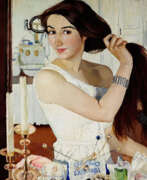

Zinaida Yevgenyevna Serebriakova (Russian: Зинаида Евгеньевна Серебрякова) was a Russian painter known for her lifelike portraits and depictions of rural life, which resonate with warmth and a profound sense of humanity. Born into the distinguished Benois family in 1884, her early life was immersed in art, guided by notable figures like her grandfather, Alexandre Benois, and influenced by her study trips to Italy and under the mentorship of Ilya Repin and Osip Braz. Her marriage to Boris Serebriakov further enriched her artistic environment, enabling her to produce works that captured the simple joys and the intrinsic beauty of her surroundings.
Serebriakova's art gained significant attention with her self-portrait "At the Dressing-Table" (1909) and continued with notable works like "Peasants" (1914–1915) and "Bleaching Cloth" (1917), highlighting her exceptional skill in portraying the Russian countryside and its inhabitants with a blend of grandeur and intimacy. Her ability to imbue her canvases with the spirit of her subjects, whether through the dignified depictions of peasant life or the intimate portrayals of her family, set her apart in the Russian art scene of the early 20th century.
The October Revolution of 1917 marked a turning point in Serebriakova's life, leading to personal tragedies and a shift in her artistic medium due to financial constraints. Despite these challenges, her resilience and dedication to art remained steadfast, evident in her works from this period that include poignant family portraits and explorations of new subjects in the realm of theatre and ballet.
In 1924, Serebriakova moved to Paris, where her art evolved through influences from travels, notably her trips to Morocco, capturing the vibrancy of landscapes and local cultures. Yet, the essence of her work—characterized by a celebration of beauty and life—remained consistent throughout her career. Although separated from her homeland for many years, the recognition of her art in the Soviet Union before her death in 1967 affirmed her lasting impact on Russian and French art.
Zinaida Serebriakova's legacy is a testament to her indomitable spirit and artistic prowess, making her one of the most cherished painters of her time. Her works continue to be celebrated for their technical brilliance, emotional depth, and the unique perspective she offered on the beauty of everyday life.
For collectors and experts in art and antiques, Serebriakova's works offer a window into the soul of early 20th-century Russia and France, embodying the universal themes of family, work, and the natural world with unparalleled sensitivity and grace. To stay updated on sales and auction events featuring Zinaida Yevgenyevna Serebriakova's works, signing up for updates is a step toward owning a piece of this exceptional artistic legacy.
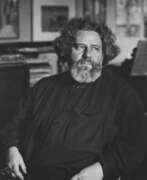

Maximilian Alexandrovich Voloshin (Russian: Максимилиа́н Алекса́ндрович Волошин) was a multifaceted Russian figure, known for his profound contributions as a poet, artist, literary critic, art historian, mystic, philosopher, and journalist. His work, deeply intertwined with the landscapes of Crimea and the ancient, complex terrains of Koktebel, reflects a geological, philosophical, and pantheistic precision, rather than geographical accuracy. Voloshin's watercolors of Crimean landscapes, notable for their lack of geographical precision but profound depth in geological and philosophical terms, are celebrated for capturing the essence of Crimea's natural beauty. His poetry and art, deeply influenced by symbolist movements, did not align with any single avant-garde art group, showcasing his unique stance as both an artist and a poet. Voloshin's life was a testament to his eccentricity and depth, filled with intellectual pursuits, extensive travels, and a commitment to community and humanism, particularly evident in his efforts during the tumultuous times of the Russian Civil War, where he sought to mediate between opposing factions.
Voloshin's contributions to Russian culture are significant, with his works offering insights into Russian history and philosophy. Despite periods of obscurity, particularly under Soviet rule, his legacy as a key figure of the Russian Silver Age endures, with his home in Koktebel now serving as a museum and a place of pilgrimage for many. His poetry, characterized by its philosophical depth and historical insight, has found resonance in modern times, not only within literary circles but also in music, with bands like Little Tragedies setting his poems to music.
For those interested in exploring the profound and visionary works of Maximilian Voloshin, his poetry and art continue to offer a window into the soul of Russian history and the natural beauty of Crimea. Collectors and experts in art and antiques might find the exploration of Voloshin's work both enriching and enlightening.
For updates related to Maximilian Alexandrovich Voloshin, including new product sales and auction events featuring his work, sign up for our newsletter. Stay connected with the legacy of a visionary poet and artist whose work transcends time and geography.


Stepan Petrovich Yaremich (Russian: Степан Петрович Яремич) was a multifaceted Ukrainian artist and art historian, whose career spanned the late 19th and early 20th centuries. His profound contributions to art history and preservation, particularly during the tumultuous post-revolutionary period in Russia, underscore his significance beyond his work as a painter. Yaremich's expertise in Western European drawing, bolstered by his years in Paris where he amassed an impressive collection featuring masters like Watteau and Fragonard, highlighted his remarkable connoisseurship.
Educated in Kiev and Paris, Yaremich was associated with the "World of Art" movement and worked closely with figures like Alexandre Benois. He was not just an artist but a respected art expert, often involved in the restoration and cataloging of Russian and Western European art. His time at the Hermitage and Russian Museum showcased his dedication to art preservation, contributing significantly to the fields of art history and conservation.
Yaremich's artistic legacy includes landscapes of St. Petersburg, Venice, and other locales, characterized by a unique approach to color and form that distinguished his work from his contemporaries. Despite the critical acclaim, it was his behind-the-scenes work as an art historian and conservator that solidified his enduring impact on the art world.
Collectors and experts in art and antiques will find Yaremich's work both compelling and significant, underlining the importance of not only creating art but also preserving it for future generations. For updates related to Stepan Petrovich Yaremich, including sales and auction events, sign up for our newsletter. This subscription will keep you informed about the latest findings and opportunities to acquire works associated with this remarkable figure in art history.
